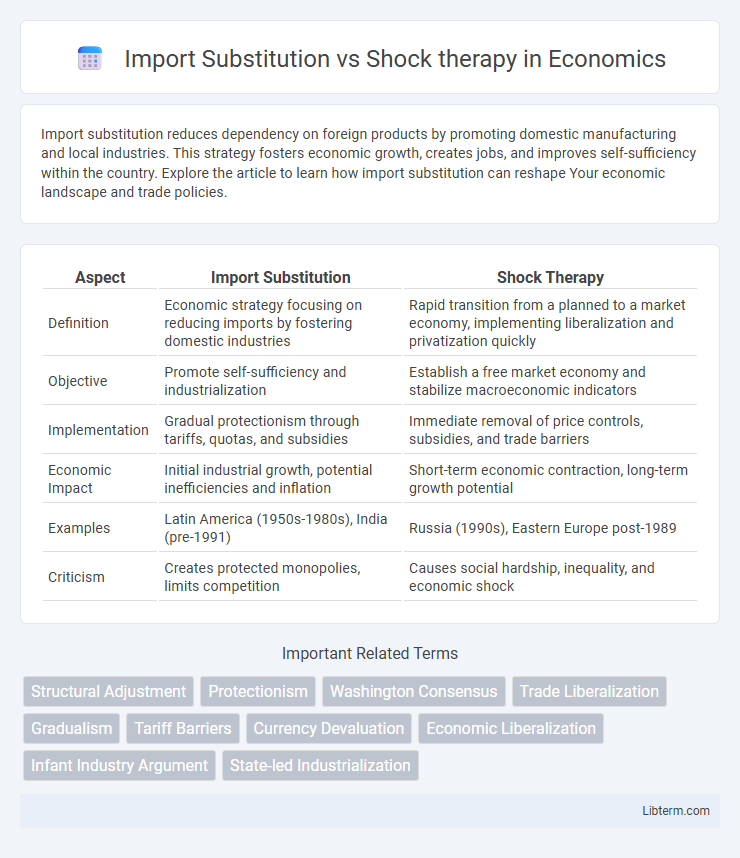Import substitution reduces dependency on foreign products by promoting domestic manufacturing and local industries. This strategy fosters economic growth, creates jobs, and improves self-sufficiency within the country. Explore the article to learn how import substitution can reshape Your economic landscape and trade policies.
Table of Comparison
| Aspect | Import Substitution | Shock Therapy |
|---|---|---|
| Definition | Economic strategy focusing on reducing imports by fostering domestic industries | Rapid transition from a planned to a market economy, implementing liberalization and privatization quickly |
| Objective | Promote self-sufficiency and industrialization | Establish a free market economy and stabilize macroeconomic indicators |
| Implementation | Gradual protectionism through tariffs, quotas, and subsidies | Immediate removal of price controls, subsidies, and trade barriers |
| Economic Impact | Initial industrial growth, potential inefficiencies and inflation | Short-term economic contraction, long-term growth potential |
| Examples | Latin America (1950s-1980s), India (pre-1991) | Russia (1990s), Eastern Europe post-1989 |
| Criticism | Creates protected monopolies, limits competition | Causes social hardship, inequality, and economic shock |
Introduction to Import Substitution and Shock Therapy
Import Substitution Industrialization (ISI) emphasizes developing domestic industries by reducing reliance on foreign imports through tariffs, subsidies, and government support, aiming to stimulate local production and self-sufficiency. Shock therapy refers to rapid, comprehensive economic reforms implemented to transition from a centrally planned economy to a free-market system, involving sudden removal of price controls, trade liberalization, and privatization. Both strategies target economic transformation but differ in approach: ISI promotes gradual protectionism, while shock therapy advocates swift market liberalization.
Historical Context of Economic Reform Strategies
Import substitution industrialization (ISI) emerged in Latin America and Asia during the mid-20th century as a strategy to reduce foreign dependency by promoting domestic industries through tariffs and subsidies, aiming to foster self-sufficiency. In contrast, shock therapy was adopted in the early 1990s primarily in post-Soviet states and Eastern Europe, focusing on rapid market liberalization, privatization, and stabilization to transition quickly from centrally planned to market economies. The historical context of these reforms highlights ISI's protectionist roots amid decolonization, while shock therapy reflects a neoliberal response to systemic economic collapse and hyperinflation.
Core Principles of Import Substitution
Import substitution centers on developing domestic industries by reducing reliance on foreign products through protective tariffs, subsidies, and import restrictions. It emphasizes self-sufficiency, building local manufacturing capabilities, and fostering economic independence. Core principles include nurturing infant industries, promoting local entrepreneurship, and gradually replacing imported goods to stimulate internal market growth.
Key Tenets of Shock Therapy
Shock therapy centers on rapid economic liberalization, including swift privatization, removal of price controls, and opening markets to international trade. It emphasizes stabilization through tight fiscal and monetary policies aimed at curbing hyperinflation and restoring economic order. Key tenets include deregulation, fiscal discipline, and the creation of a market-driven economy to replace centrally planned systems.
Case Studies: Latin America and Eastern Europe
Latin American countries implementing Import Substitution Industrialization (ISI) between the 1950s and 1980s, such as Brazil and Mexico, aimed to reduce foreign dependency by fostering domestic industries, but often faced inefficiencies and inflation. In contrast, Eastern European nations like Poland and Russia adopted Shock Therapy in the 1990s, rapidly transitioning from centrally planned to market economies through sudden liberalization, privatization, and stabilization measures, which initially caused significant economic contraction and social hardship. Comparative case studies reveal ISI's long-term challenges with industrial competitiveness, while Shock Therapy's rapid reforms led to quicker market adjustment but with high short-term socio-economic costs.
Economic Outcomes and Performance Comparison
Import substitution led to moderate GDP growth by fostering domestic industries but often resulted in inefficient resource allocation and persistent trade imbalances. Shock therapy triggered rapid market liberalization, causing initial sharp declines in output and employment but ultimately promoting higher economic efficiency and integration into global markets. Comparative analysis shows shock therapy yields faster long-term economic stabilization and growth, whereas import substitution provides short-term industrial development with limited competitiveness.
Social and Political Impacts
Import substitution industrialization often fosters social stability by protecting domestic industries and preserving jobs, but may lead to inefficiencies and political patronage. Shock therapy, characterized by rapid market liberalization, can cause significant social upheaval through unemployment and inequality, fueling political unrest and weakening trust in government. Both approaches deeply influence the social fabric and political landscape, shaping economic reforms and public acceptance.
Criticisms and Controversies
Import substitution industrialization (ISI) faces criticism for causing inefficiencies, fostering dependency on government protection, and limiting competitiveness by shielding domestic industries from global markets. Shock therapy, implemented in post-communist economies, is controversial due to its rapid privatization leading to social inequality, economic instability, and the erosion of public welfare systems. Both strategies spark debates over their long-term impacts on sustainable development and economic resilience.
Lessons Learned for Policy Makers
Import substitution industrialization (ISI) demonstrates the effectiveness of protecting nascent domestic industries through tariffs and subsidies, fostering local capacity and reducing dependency on imports in developing economies. Shock therapy, characterized by rapid market liberalization, privatization, and deregulation, often leads to short-term economic instability and social hardship but can accelerate integration into global markets when managed carefully. Policy makers should balance gradual reforms with targeted support for domestic sectors, ensuring institutional capacity and social safety nets to mitigate the adverse impacts of sudden economic transitions.
Future Perspectives on Economic Transformation
Import substitution fosters long-term industrial diversification by reducing dependency on foreign goods and promoting local manufacturing, essential for sustainable economic transformation. Shock therapy accelerates economic liberalization and market integration, aiming for rapid efficiency gains but often risks social instability and uneven development. Future economic strategies should balance gradual structural reforms from import substitution with selective shock therapy measures to achieve resilient and inclusive growth.
Import Substitution Infographic

 libterm.com
libterm.com